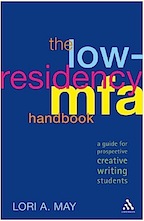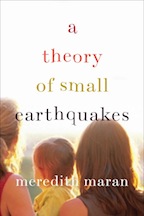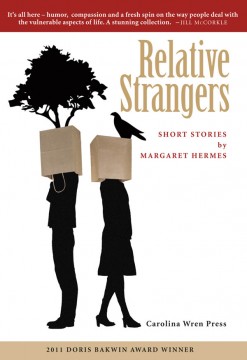
Book Reviews: June 2012
The Children, Poetry by Paula Bohince
A Bird Black as the Sun: California Poets on Crows & Ravens,Poetry anthology
The Low Residency MFA Handbook: A Guide for Prospective Creative Writing Students, Nonfiction by Lori A. May
Windeye, Fiction by Brian Evenson
A Theory of Small Earthquakes, Fiction by Meredith Maran
Relative Strangers, Fiction by Margaret Hermes
Self-Published Books
Speculation, Fiction by Edmund Jorgensen
fff
 The Children
The Children
Poetry by Paula Bohince
ISBN-13: 978-1936747283
Sarabande Books, May 2012
$14.95, 80pp.
Reviewed by Kelly Forsythe
Posted June 2012
Paula Bohince’s sophomore book, The Children, explores the peaks and depths of life, both human and animal. Her poetry is not simply an investigation of childhood, but rather a gathering of beautiful observations about the aged, the dead, the living, and the never-were-alive. While innocence is certainly found in the warm movements between stanzas: “Falsetto streams cut toward, / giving us creatures to briefly enter / our virgin lives,” it is pierced by a careful violence.
How long
I’d slept: on my wrist,
the loved bracelet—
scales of brass, garnet-
eyed. Tail
clasped in fangs,
it encircles the slow
wrist bones, warms to skin
and down.
With lyrical mastery, Bohince pulls forth the feminine and spreads silent ashes, layers images of nature as it collides with humanity. In the poem “Dogwood,” she writes: “Was not canine, not human, but / angelic. / What a fragile word, itself on the verge / of breaking.” The attention to language creates a sonic brevity that almost feels airborne, as if one is floating into the bee-filled sky, breathless, speechless. This “pink-cheeked” buoyancy, however, is balanced by a level of dense emotional content. The Children is not without moments of melancholy, fierce edges, and intense wondering. In “Everywhere I Went that Spring, I Went Alone,” Bohince writes:
Everywhere
those months my nose buzzed
from crying. Quivered so unlike the hornet, pitiless
in her work. Bleeding intermittently
into my dress hem, how beautiful I became
then, ringed by brown flowers. More
hornet than my hornet friend, alone in her own
collapsing universe.
Aptly titled, The Children illuminates a kind of contemporary nostalgia, one that pursues an innocence found only in childhood without forsaking the beautiful complexities of aging and the natural evolution of the wildlife around us: “Virus in my heart. Branches / salted with buds, soft- / eyed on a sill.”
 A Bird Black as the Sun: California Poets on Crows & Ravens
A Bird Black as the Sun: California Poets on Crows & Ravens
Poetry, Edited by Enid Osborn and Cynthia Anderson
ISBN-13: 978-061553632-3
Green Poet Press, 2011
$15.00, 161pp.
Reviewed by Doug Ramspeck
Posted June 2012
Crows and ravens appear often as the trickster in aboriginal myths. Indeed, Native-American tribes have historically associated the birds not only with the mischievous and the sacred, but with shape-shifting. It is no surprise, then, that the diverse poems in A Bird Black as the Sun run through shapes ranging from the playful, through the ominous, to the spiritual. This is not to say, of course, that the collection does not begin to coalesce around identifiable themes and motifs. The final poem, for example, “What the Crow Said,” by Michael Hannon, addresses, in three brief lines, one of the primary concerns of the book:
Though friendly to magic
I am not a man disguised as a crow.
I am night eating the sun.
Although a certain portion of the poems in this collection personify crows and ravens, reading into their existence our own human shape, more often these birds are represented as the “other,” or, perhaps more precisely, represented as the other that resides inside us, that part of our own nature that is primitive, often unnerving, and inaccessible. For example, in “Giving Birth to Ravens,” by ellen, the “woman” in the poem is described as existing in a “pre-natural state.” In “Bird of Paradox,” by Glenna Luschei, we read the line, “I understood now why Raven / stole the sun”; and in “Lasswade, Midlothian: Dusk,” by Cecilia Woloch, we learn that “Here is a world / that is just as the world was world / before we named it world.”
In the Haida creation myth, the Raven persuaded the first people to emerge from a great clam shell. In A Bird Black as the Sun—an accessible and riveting collection—crows and ravens coax from the page the human story and landscape, while still maintaining their own elemental mystery.
 The Low Residency MFA Handbook: A Guide for Prospective Creative Writing Students
The Low Residency MFA Handbook: A Guide for Prospective Creative Writing Students
Nonfiction by Lori A. May
ISBN-13: 978-1441198440
Continuum, 2011
$19.95, 238pp.
Reviewed by Renée K. Nicholson
Posted June 2012
If you’re committed enough to your writing to want to pursue an MFA, it’s worth the investment of time to research programs thoroughly. Lori A. May’s The Low Residency MFA Handbook: A Guide for Prospective Creative Writing Students makes that research more efficient.
May skillfully explains the differences between a low residency MFA and full-residency programs, helping the reader to understand more about his or her options when applying. Her guide also provides useful information on various low residency programs, financial considerations, information on AWP (The Association of Writers and Writing Programs) and much more. It’s a thoughtful approach for considering MFA programs, and while much of the information is applicable to either MFA model, May gives a blueprint for success with the low residency format in mind.
A section of the book particularly helpful to the prospective student is the chapter on selecting a school and program. “Think about what you most desire in a program; this will go hand-in-hand with thinking about the writer you currently are and the writer you want to be,” advises May. “It’s always good practice to think about how to move your writing forward and, if you haven’t already, it’s a good idea to start thinking about setting goals for your creative development.”
May then guides the reader through a series of important considerations, including travel and budget for the residencies, program curriculum, time and flexibility, faculty, thesis, student and alumni success, alumni community, visiting writers and special guests, readings and events, editing and publishing experience, teaching, community outreach, tuition and funding, and formats of study. May suggests using these categories to develop a personal checklist of “wants.” She wisely advises students to be choosy when it comes to the most important aspects of a program by balancing these categories with an open mind about what the various programs can offer.
The book also features interviews with program directors, faculty, current students and alumni, and includes a robust listing of low residency programs as well as an appendix of additional resources.
 Windeye
Windeye
Fiction by Brian Evenson
ISBN-13: 978-1566892988
Coffee House Press, 2012
$16.00, 188pp.
Reviewed by Daniel Wallace
Posted June 2012
Windeye, Brian Evenson’s collection of literary horror, is great fun to read. Highly recommended. Reading Evenson’s stories, I was brought back to my teenage years, staying awake in a sleeping house in order to consume one Stephen King short story after another, each awful ending leaving me only more eager for the next.
These tales wrestle with mighty opposites. On the one hand, Evenson excels at constructing “conventional” horror stories: a protagonist senses the presence of something strange and terrifying; the terrifying thing then manifests in some horrible way; the protagonist must, in order to survive, go into the horror, go deeper in order to escape. Apprehension, then fright, then terror. Yet, on the other hand, Evenson’s stories are very literary, their protagonists frequently finding that storytelling itself is suspect, that memory, identity, and explanation offer no help, that brothers, sisters, and parents may not be what they seem (or may never have existed at all).
In the collection’s best stories, the wedding of these two forces produces remarkable things. “Hurlock’s Law” begins as a low-key, wry piece of magic realism, and then Evenson wrenches the story wide open—suddenly, the narrator is not who we thought he was, our universe is not what we thought it was—and in the story’s final moments, he wrenches its world open a second time, hinting at an even greater malevolence. “The Sladen Suit,” “The Absent Eye,” “The Other Ear,” and “Legion” are all blood-chilling, mind-tricking stories that will have you holding your hand over the bottom half of the page, so as not to see the next shock too soon.
Not all the collection’s stories, however, are such happy marriages. Tales such as “Baby or Doll” and “The Drownable Species” seemed more indeterminate than perplexing, their unreliable protagonists and vague events left to stand gauntly post-modern-ish before the confused reader’s eyes. If they were meant to entice as puzzles, they needed to first intrigue. And a few stories, in contrast, felt too accepting of the genre’s devices and moods, too willing to posit something horrible and then conclude, lacking the final shock or twist they seemed to beg for.
These are small complaints. Windeye is a real pleasure—constantly inventive, remarkably varied in theme and tone. The final story, “Anskan House,” is quiet, understated, noble in parts, and lets us know that once you enter the darkness, you never return unchanged.
 A Theory of Small Earthquakes
A Theory of Small Earthquakes
Fiction by Meredith Maran
ISBN-13: 978-1593764302
Soft Skull Press, 2012
$15.95, 346pp.
Reviewed by Dani Burlison
Posted June 2012
Writer and journalist Meredith Maran’s debut novel, A Theory of Small Earthquakes, is captivating from the first line, tempting the reader to erase the day’s obligations and spend it within these pages instead.
An only child with both parents gone, Maran’s lead, Alison, is driven, reserved, shielding herself from intimacy, avoiding risks that have the potential to leave her orbiting alone through space.
But then she falls in love.
Lured to the Bay Area in the 1980s, with no families or deep connections tethering them to their east coast beginnings, Alison and her college sweetheart move west. It is there, among the fault lines of Berkeley’s activist-artist-Bohemian community that the couple lays the groundwork for a relationship which, through twists and turns, heartbreak and loss, grows and morphs through the times, the earth quite literally shifting beneath their feet.
Things change, the earth shakes. Alison finds herself pressed between two factions of her life, facing decisions that she never imagined confronting.
Maran’s attention to the people in the feminist theory classes, cafés and radical meeting spaces, political magazine parties, and East Bay neighborhoods is spot-on and often hilarious. The light she shines on the human condition with its unpredictable and countless emotions is lovely. And heartbreaking. And real.
Maran’s daring and honest look at the complexities of modern relationships reminds us that the love we need and the families we long for don’t always arrive at our doorsteps wrapped in neatly packaged boxes. More than just a story of passion and the fragility of first love, A Theory of Small Earthquakes is an illustration of the complex world we live in, the risks we take to satisfy our desires and the delicate balance between loving wildly and letting go. Maran shows us that regardless of the old stories we tell ourselves, the courage to accept the love we deserve—from ourselves as well as others—always wins in the end, often revealing a prize that has been there all along.
 Relative Strangers
Relative Strangers
Fiction by Margaret Hermes
ISBN-13: 978-0932112620
Carolina Wren Press, May 2012
$15.95, 170 pp.
Reviewed by Lori A. May
Posted June 2012
The winner of the 2011 Doris Bakwin Award shares fourteen stories that may have no direct relation to one another, yet their commonalities in the bittersweet moments of life weave together a narrative that binds. The stories are short, but the characters’ histories are deep and immediately intimate to the reader; Hermes has a knack for inviting the reader into her prose with brevity amid description.
There’s something about the way Hermes’ characters portray themselves to their external worlds while battling their conflicting inner selves that makes them so human, so relatable, and yet so intriguingly dysfunctional. Where happy marriages result in infidelity and dead-end marriages end up prolonged, Hermes’ characters may be questioned, but the author’s skills needn’t be; this is an inviting collection that reveals more about human nature than the sparseness on the page may indicate at first glance.
A coming-of-age boy visits a family farm where he leaves more than just a bit of his innocence behind at the end of summer, after developing an attachment to a suspicious poultry salesman. A couple married for nearly thirty years faces physical and emotional change after being carjacked. A household of offspring and lies prove nothing is what it seems—even concrete matter like genes. A woman drawn to the river is the star of her story, even while never actually appearing on the page.
Reading Relative Strangers is like peeling away layers of onions, with new realities uncovered in each crisp, tangy reveal. There’s the ever-present reminder that we never really know another’s reality—and sometimes never know our own. Hermes’ stories don’t have punch lines; the punch is in the overall delivery and in getting to know characters real enough to haunt off-page.
 Speculation
Speculation
Fiction by Edmund Jorgensen
ISBN-13: 978-0984749294
$12.00, 270pp.
Reviewed by Joe Ponepinto
Edmund Jorgensen’s Speculation harkens back to the days of heavyweight fiction—to the novels of Bellow and Mailer and Murdoch—when themes were as important as characters, and moral dilemmas mattered as much as plot.
The protagonist, Andy, is faced with such a challenge on the death of his friend, known as Sothum. A reading of the will leaves Andy with a choice between a check for ten million dollars and a sealed envelope. Andy is a professor of Philosophy, and his friend was an explorer of the nature of reality and the belief it was possible to know God—so how could Andy possibly choose? What mystical secret might be contained within that slim vessel that might be worth more than the financial freedom the money would bring? Cheryl, his wife, thinks the answer is easy. But for a philosopher, even the simplest choices carry the weight of humanity’s history of critical thinking.
Philosophy, at its core, is the consideration of options and possibilities, the belief that actions and decisions have meaning and repercussions, and Speculation does not disappoint in that regard. The characters are more than simple actors; the plot is far more than a series of events—every issue carries with it a philosophical component, an analysis of what impacts the available choices and their outcomes might mean to the people involved. And Jorgensen is not afraid to have his cast talk through their situations as they try to reach the ultimate philosophical goal: compromise that is satisfactory to all parties, a solution that seems to have been lost on both our literary and contemporary cultures. Life, in Speculation, is still a discussion of ideas and ideals, an exploration of the self, and of our place in universe.
By the standards of today’s MFA-dominated literary culture, Speculation has some issues. It’s heavy on backstory and short on forward momentum. But even these aspects of the book could be considered accurate reflections of the philosopher’s world. And who said the good, old-fashioned, thoughtful novel is dead? Although current fiction is populated mostly by characters who only react and lament their situations, there may still be room for actors like those in this book, who try to think their problems through to a rational solution. Speculation is the kind of novel people used to read a few decades ago, and might like to try again today.
